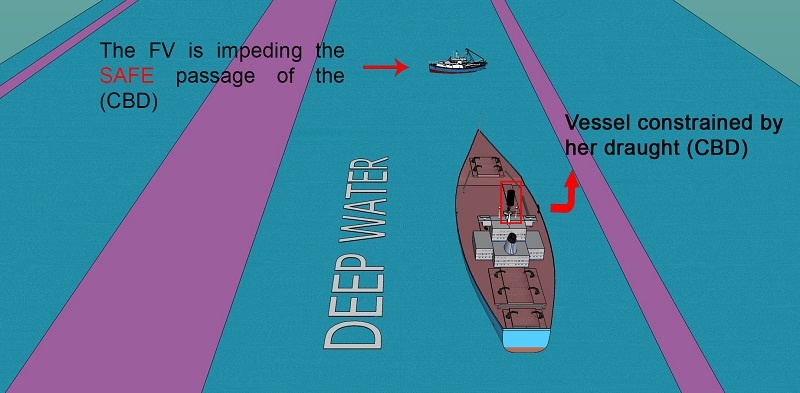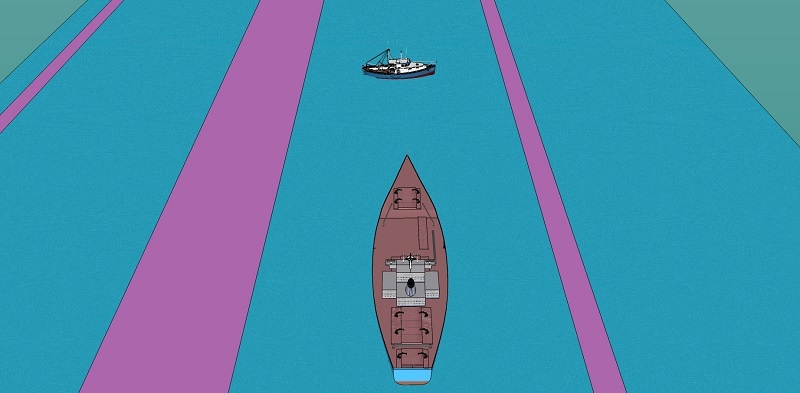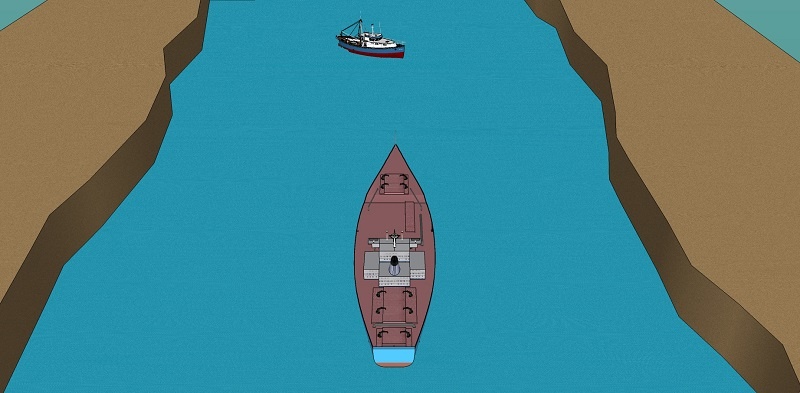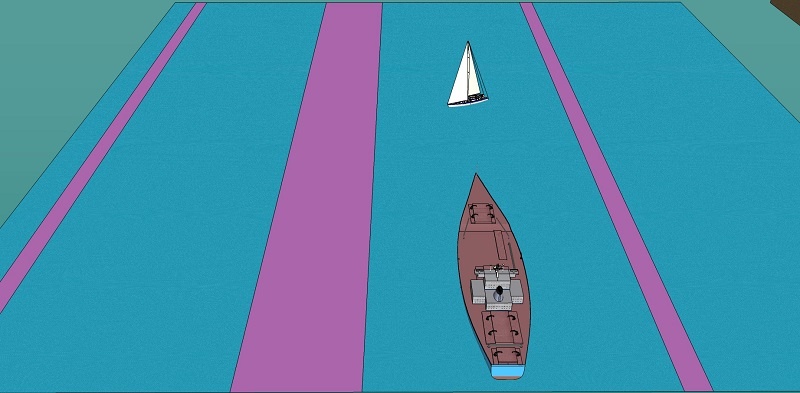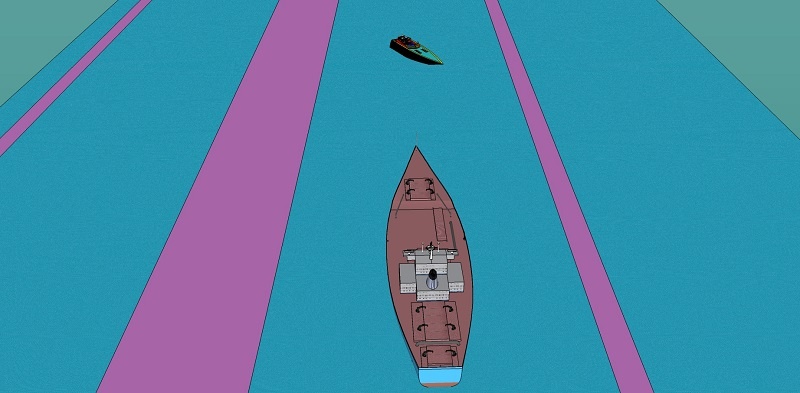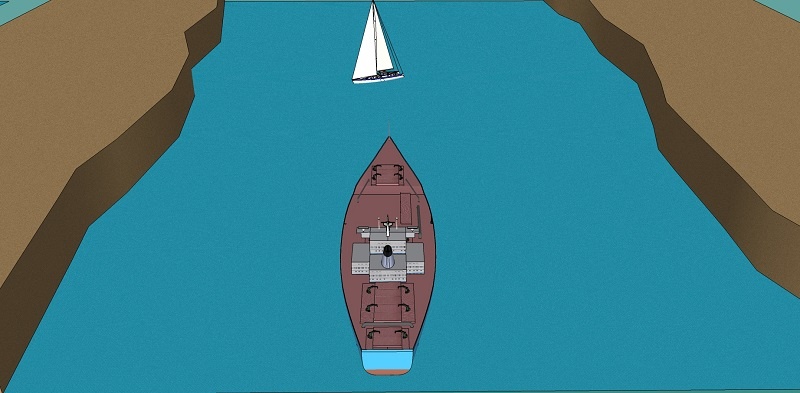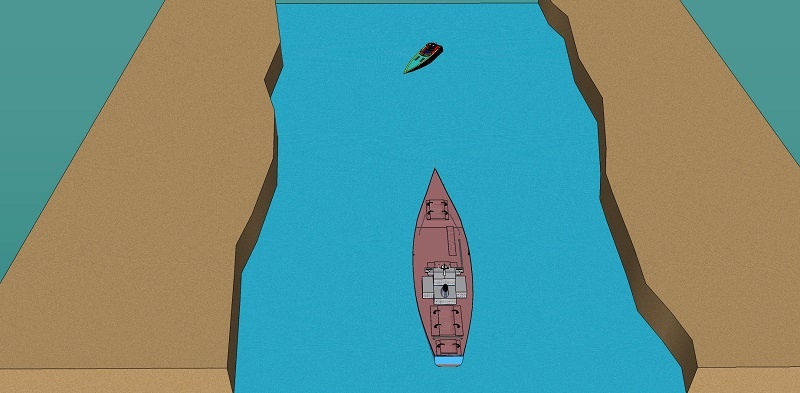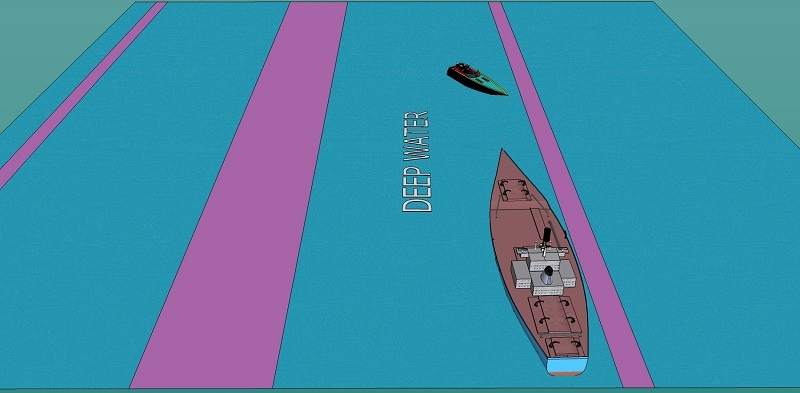Before we start with the situations, we need to focus on some important Rules and Phrases and they are:
THE RULES:
- Rule 8 (f)
- Rule 9
- Rule 10
- Rule 18.
All the rules mentioned above have a connection between them and it will be explained in the examples later.
THE PHRASES:
There are two phrase that must be understood before continue with the explanation, which they are:
Notice
Situations like Head-On, Crossing and Overtaking Inside Narrow Channel and Traffic Separation Scheme (TSS) will be solved the same way like the examples below
FISHING VESSEL
(IMPEDE THE PASSAGE)
Traffic Separation Scheme
As per the picture above, the first rules will be applied are Rule 10(A) and Rule 18(A).
Rule 10(a): “This Rule applies to Traffic separation schemes adopted by the Organization and does not relieve any vessel of her obligation under any other rule.”
Rule 18(a): “A power-driven vessel underway shall keep out of the way of: a vessel engaged in fishing.”
In this case Power-Driven Vessel (PDV) has to keep clear of Fishing Vessel (FV), But by reading the first line in Rule 18:
Rule 18: “Except where Rules 9, 10 and 13 otherwise require”
By going back to Rule 10(i) and Rule 8(f)(i) You will notice that, the (FV) should take early action to avoid collision.
Rule 10(i): “A vessel engaged in fishing shall not impede the passage of any vessel following a traffic lane.”
Rule 8(f)(i): “A vessel which, by any of these Rules, is required not to impede the passage or safe passage of another vessel shall, when required by the circumstances of the case, take early action to allow sufficient sea-room for the safe passage of the other vessel.”
SO
What will happen in case the (FV) did not take action?
Then the (PDV) should sound 5 short blasts as per Rule 34(d)
But if the (FV) still did not take action and risk of collision develops.
In this case the (PDV) should take action to avoid collision as per Rule 8(f)(iii).
Rule 8(f)(iii): “A vessel the passage of which is not to be impeded remains fully obliged to comply with the Rules of this Part when the two vessels are approaching one another so as to involve risk of collision.”
NOTE THAT
The action taken by (PDV) does not relieve the (FV) as per Rule 8(f)(ii).
Rule 8(f)(ii): “A vessel required not to impede the passage or safe passage of another vessel is not relieved of this obligation if approaching the other vessel so as to involve risk of collision and shall, when taking action, have full regard to the action which may be required by the Rules of this part.”
Narrow Channel
As per the picture above, the first rule will be applied is Rule 18(A).
Rule 18(a): “A power-driven vessel underway shall keep out of the way of: a vessel engaged in fishing.”
In this case Power-Driven Vessel (PDV) has to keep clear of Fishing Vessel (FV), But by reading the first line in Rule 18:
Rule 18: “Except where Rules 9, 10 and 13 otherwise require”
By going back to Rule 9(c) and Rule 8(f)(i) You will notice that, the (FV) should take early action to avoid collision.
Rule 9(c): “A vessel engaged in fishing shall not impede the passage of any other vessel navigating within a narrow channel or fairway.”
Rule 8(f)(i): “A vessel which, by any of these Rules, is required not to impede the passage or safe passage of another vessel shall, when required by the circumstances of the case, take early action to allow sufficient sea-room for the safe passage of the other vessel.”
SO
What will happen in case the (FV) did not take action?
Then the (PDV) should sound 5 short blasts as per Rule 34(d)
But if the (FV) still did not take action and risk of collision develops.
In this case the (PDV) should take action to avoid collision as per Rule 8(f)(iii).
Rule 8(f)(iii): “A vessel the passage of which is not to be impeded remains fully obliged to comply with the Rules of this Part when the two vessels are approaching one another so as to involve risk of collision.”
NOTE THAT
The action taken by (PDV) does not relieve the (FV) as per Rule 8(f)(ii).
Rule 8(f)(ii): “A vessel required not to impede the passage or safe passage of another vessel is not relieved of this obligation if approaching the other vessel so as to involve risk of collision and shall, when taking action, have full regard to the action which may be required by the Rules of this part.”
VESSEL OF LESS THAN 20 METRES IN LENGTH OR A SAILING VESSEL
(IMPEDE THE PASSAGE)
Traffic Separation Scheme
As per the pictures above, the Sailing Vessel (SV) and vessel of less than 20 metres in length impeding the passage of (PDV) and NOT the SAFE passage, the first rules will be applied are Rule 10(j) and Rule 18(a).
Rule 10(j): “A vessel of less than 20 metres in length or a sailing vessel shall not impede the safe passage of a power-driven vessel following a traffic lane.”
Rule 18(a): “A power-driven vessel underway shall keep out of the way of: a sailing vessel.”
In this case Power-Driven Vessel (PDV) should take immediate action without sounding the 5 short blasts to avoid collision and keep clear of vessel of less than 20 metres in length or a sailing vessel .
Narrow Channel
As per the pictures above, the Sailing Vessel (SV) and vessel of less than 20 metres in length impeding the passage of (PDV) and NOT the SAFE passage, the first rules will be applied are Rule 9(b) and Rule 18(a).
Rule 9(b): “A vessel of less than 20 metres in length or a sailing vessel shall not impede the passage of a vessel which can safely navigate only within a narrow channel or fairway.”
Rule 18(a): “A power-driven vessel underway shall keep out of the way of: a sailing vessel.”
In this case Power-Driven Vessel (PDV) should take immediate action without sounding the 5 short blasts to avoid collision and keep clear of vessel of less than 20 metres in length or a sailing vessel .
VESSEL OF LESS THAN 20 METRES IN LENGTH OR A SAILING VESSEL
(IMPEDE THE SAFE PASSAGE)
Traffic Separation Scheme
As per the picture above, the first rules will be applied are Rule 10(a) and Rule 18(a).
Rule 10(a): “This Rule applies to Traffic separation schemes adopted by the Organization and does not relieve any vessel of her obligation under any other rule.”
Rule 18(a): “A power-driven vessel underway shall keep out of the way of: a sailing vessel.”
In this case Constrained By her Draught Vessel (CBD) has to keep clear of Sailing Vessel (SV) and vessel of less than 20 metres in length, But by reading the first line in Rule 18:
Rule 18: “Except where Rules 9, 10 and 13 otherwise require”
By going back to Rule 10(i) and Rule 8(d)(i) and Rule 8(f)(i) You will notice that, the (SV) should take early action to avoid collision.
Rule 10(i): “A vessel of less than 20 metres in length or a sailing vessel shall not impede the safe passage of a power-driven vessel following a traffic lane.”
Rule 8(d)(i): “Any vessel other than a vessel not under command or a vessel restricted in her ability to manoeuvre shall, if the circumstances of the case admit, avoid impeding the safe passage of a vessel constrained by her draught, exhibiting the signals in Rule 28.”
Rule 8(f)(i): “A vessel which, by any of these Rules, is required not to impede the passage or safe passage of another vessel shall, when required by the circumstances of the case, take early action to allow sufficient sea-room for the safe passage of the other vessel.”
SO
What will happen in case the Sailing Vessel (SV) and vessel of less than 20 metres in length did not take action?
Then the (CBD) should sound 5 short blasts as per Rule 34(d)
But if the Sailing Vessel (SV) and vessel of less than 20 metres in length still did not take action and risk of collision develops.
In this case the (CBD) should take action to avoid collision as per Rule 8(f)(iii)
Rule 8(f)(iii): “A vessel the passage of which is not to be impeded remains fully obliged to comply with the Rules of this Part when the two vessels are approaching one another so as to involve risk of collision.”
NOTE THAT
The action taken by (CBD) does not relieve the Sailing Vessel (SV) and vessel of less than 20 metres in length as per Rule 8(f)(ii)
Rule 8(f)(ii): “A vessel required not to impede the passage or safe passage of another vessel is not relieved of this obligation if approaching the other vessel so as to involve risk of collision and shall, when taking action, have full regard to the action which may be required by the Rules of this part.”
Narrow Channel
As per the picture above, the first rule will be applied is Rule 18(a).
Rule 18(a): “A power-driven vessel underway shall keep out of the way of: a sailing vessel.”
In this case Power-Driven Vessel (PDV) has to keep clear of Sailing Vessel (SV) and vessel of less than 20 metres in length., But by reading the first line in Rule 18:
Rule 18: “Except where Rules 9, 10 and 13 otherwise require”
By going back to Rule 9(b) and Rule 8(f)(i) You will notice that, the Sailing Vessel (SV) and vessel of less than 20 metres in length should take early action to avoid collision.
Rule 9(b): “A vessel of less than 20 metres in length or a sailing vessel shall not impede the passage of a vessel which can safely navigate only within a narrow channel or fairway.”
Rule 8(f)(i): “A vessel which, by any of these Rules, is required not to impede the passage or safe passage of another vessel shall, when required by the circumstances of the case, take early action to allow sufficient sea-room for the safe passage of the other vessel.”
SO
What will happen in case the Sailing Vessel (SV) and vessel of less than 20 metres in length did not take action?
Then the (PDV) should sound 5 short blasts as per Rule 34(d)
But if the Sailing Vessel (SV) and vessel of less than 20 metres in length still did not take action and risk of collision develops.
In this case the (PDV) should take action to avoid collision as per Rule 8(f)(iii).
Rule 8(f)(iii): “A vessel the passage of which is not to be impeded remains fully obliged to comply with the Rules of this Part when the two vessels are approaching one another so as to involve risk of collision.”
NOTE THAT
The action taken by (PDV) does not relieve the Sailing Vessel (SV) and vessel of less than 20 metres in length as per Rule 8(f)(ii).
Rule 8(f)(ii): “A vessel required not to impede the passage or safe passage of another vessel is not relieved of this obligation if approaching the other vessel so as to involve risk of collision and shall, when taking action, have full regard to the action which may be required by the Rules of this part.”

